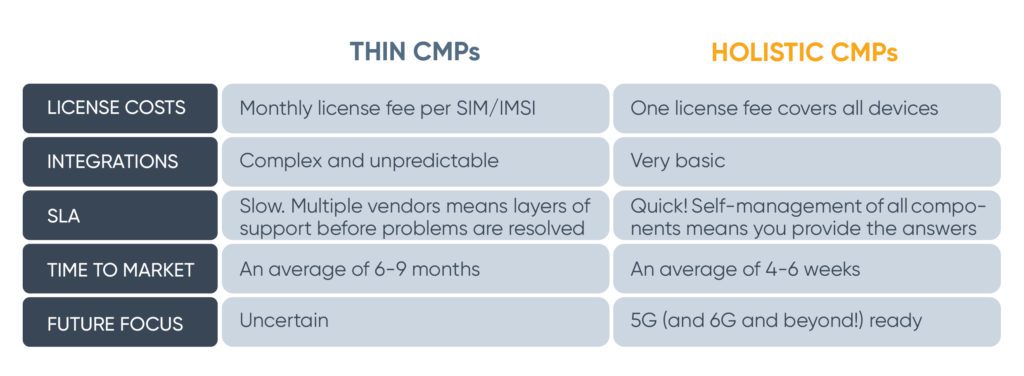What’s the Difference Between Today’s IoT Connectivity Management Platforms?

Connectivity management platforms (CMPs) give businesses and network operators the capabilities to monitor, manage, organize and update their cellular IoT deployments from a single, centralized dashboard.
However, not all connectivity management platforms (CMPs) are created equally. Let’s take a deep dive into the two ends of the spectrum, holistic CMPs that offer feature rich functionality and more inherent capabilities for IoT projects, and what we’ll call thin CMPs, those that act as an orchestration layer to streamline the existing legacy core network and applications of the mobile operator.
What can a management system offer in terms of IoT connectivity management?
Cellular devices come in all shapes and sizes. While mobile phones usually have a specific user attached, this is not the case for IoT devices. An IoT solution in the field may be unattended for years at a time, and businesses need a solution for accessing IoT data, controlling and monitoring available cellular networks, troubleshooting the connectivity service, and regulating data consumption.
Overall, to manage devices and device connectivity – enterprises, mobile operators and IoT service providers need global connectivity solutions. If you’re in the market for an IoT connectivity platform that suits long term needs, look for:
- Comprehensive IoT device management: The ability to provision SIMs over-the-air, including activating and deactivating them in real-time and assigning new SIM profiles without needing to reset the device, as well as granular control over data consumption, permissions, and usage.
- Agnostic compatibility: Connectivity technologies are changing all the time, so you need to know your CMP works with all IoT devices, no matter which form factor your SIMs come in. Device connectivity shouldn’t rely on any specific SIM card, or any specific cellular technology. Think 2G-5G, CAT-M and beyond and 2FF to MFF2.
- Inherent security: When you’re managing devices over an IoT network, you need always-on cellular connectivity and visibility. Look for a CMP that offers network slicing for businesses with added needs in terms of security, and who offers tunneling and filtering for traffic using smart firewalls and access policies.
Supercharging these benefits with a holistic CMP
These are the expectations you should have from your CMP vendor, but it’s also important to take a look under the hood. Thin Connectivity Management Platforms will utilize the core network of the mobile operator, and their Business Support Systems, or perhaps even third-party systems that come from another provider altogether. This will require you to manage complex integrations before you can go to market. In contrast, a holistic CMP has both of these attributes of your IoT project included, and built for purpose – ready for IoT needs from day one, and prepared for any requirements of scale. >>Read this article if the integrations of your Connectivity Management Platform are slowing you down<<
You might ask, do I need an integrated, built for purpose core network and BSS? Or is it just bells and whistles? Let’s look at them one by one.
Core network
An IoT core network that’s separated from the consumer core network just makes sense. Your IoT devices don’t act like consumer devices – they have totally different usages, and so you need to account for packet sizes, bulk data transfer, different requirements of latency and throughput, and many other adaptations. Critical devices will need granular policy creation and automation in place, and you can’t risk IoT devices impacting the main business – which at the moment is likely to be where the majority of your revenues are coming from.
Business support systems (BSS)
The truth is that a legacy BSS built for mobile subscribers just doesn’t suit IoT. Mobile systems are built to assume each user has one or two devices, while IoT users may have hundreds or thousands. IoT devices consume data in a totally different way, and low ARPU devices can’t be monetized in the way a mobile phone can. When you’re creating a rate plan for IoT – you need a BSS that has the functionality in place. Advanced billing and rating as part of your Connectivity Management Platform means you can invoice multiple levels of users (your customer’s customers), and deal with IoT on a global scale – supporting multiple currencies, taxation, compliance laws, and more.
Owning your own BSS is also a matter of control. When you need to make a change, you don’t have to contact the mobile operator and wait for their service. You can simply log in and use codeless development tools to just get what you need done, done.
Breaking down the benefits of different Connectivity Management Platforms
Let’s finish up by looking at how holistic CMPs measure up on key factors that make all the difference to IoT success.










